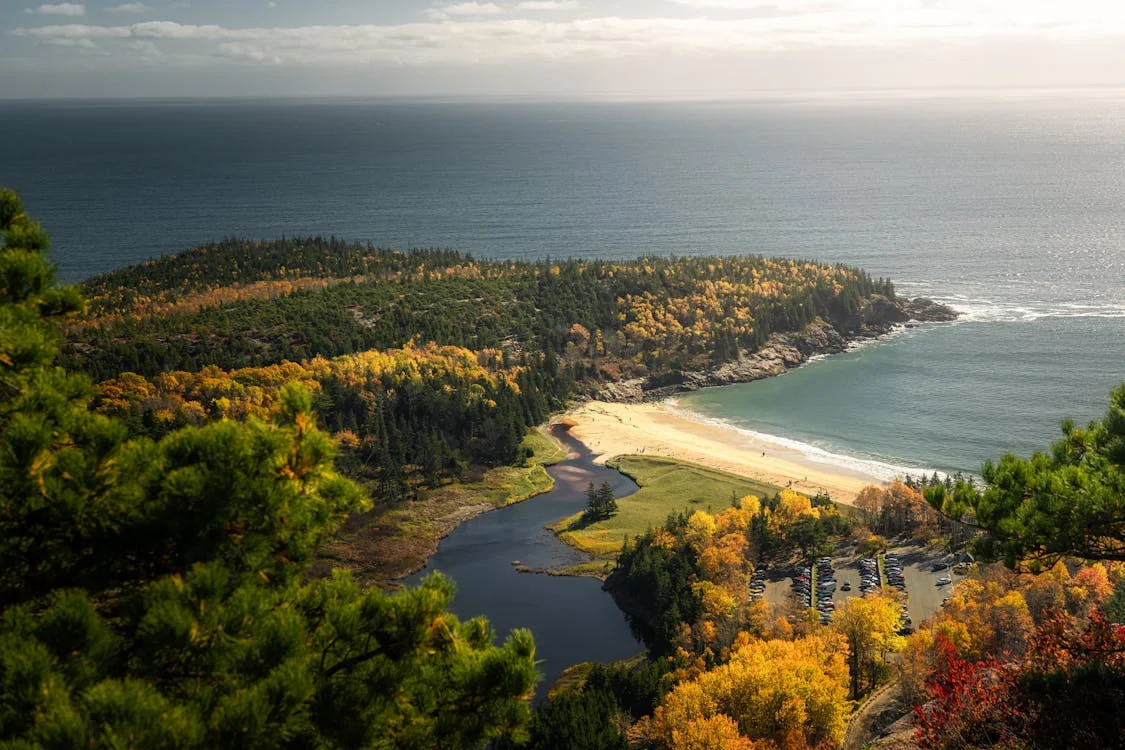Ready to swap your Wi-Fi bars for birdsong? To trade screen time for sunrise views and unexpected wildlife sightings?
Whether you’re an international explorer chasing iconic landscapes, a backpacker in search of that “just me and the trail” feeling, or a remote worker craving wild beauty beyond the co-working space, America’s national parks deliver—big time.
These protected lands aren’t just home to breathtaking hikes—they’re living, breathing ecosystems where elks roam free, eagles soar overhead, and every trail has the potential to become your own real-life nature documentary.
But here’s the thing: not all parks offer the same mix of trail quality and wildlife diversity. That’s why we’ve created this tech-savvy, trail-tested guide to the best national parks to visit for hiking and wildlife. It’s part inspiration, part strategy—so you can spend less time googling and more time spotting bison in the wild.
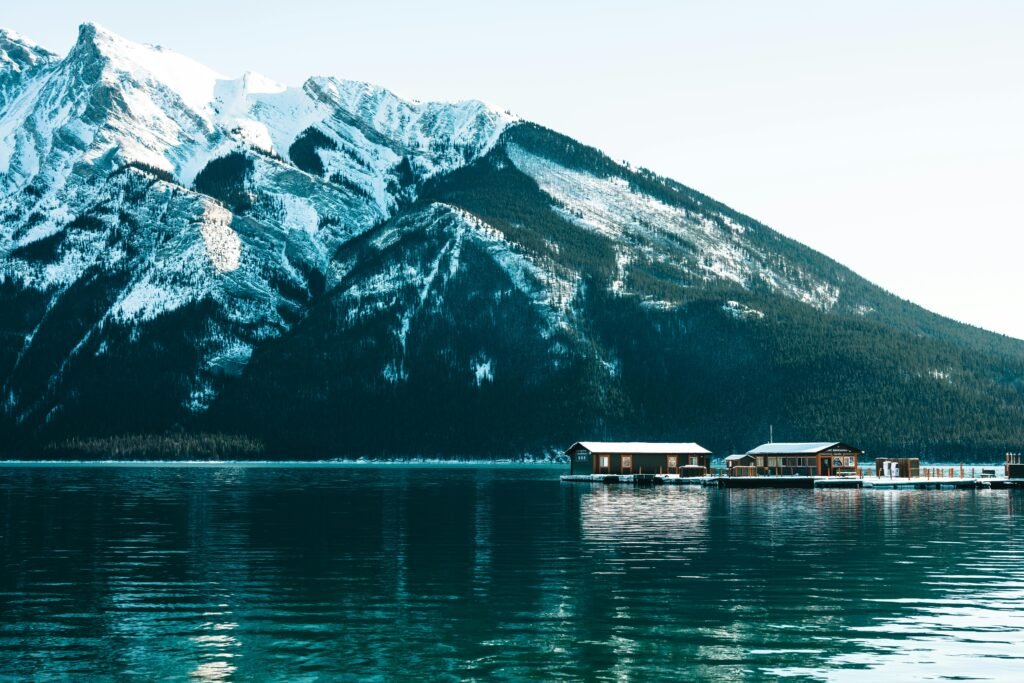
Image: Lake Minnewanka, Canada
In every walk with Nature one receives far more than he seeks
Unknown
I. Why Pair Hiking with Wildlife Spotting?
Let’s be honest—conquering a tough trail is a high in itself. But now imagine hitting that summit and spotting a herd of wild elk grazing in the valley below. Or pausing mid-hike as a bald eagle swoops across a crystal-clear alpine lake. Goosebumps, right?
When the right trail meets the right timing, hiking becomes more than movement—it becomes a memory. And many of the USA’s top national parks are designed by nature to give you both: soul-stirring trails and unforgettable wildlife encounters.
In this guide, we’ll show you:
- How to pick the right parks for both terrain and creatures
- When and where to go for the best chances of sightings
- Tech tools and tips to maximize your connection with nature, not just the internet
Let’s lace up and head out—the wild is waiting.
II. Top National Parks for Incredible Hiking and Wildlife
We’re not just tossing out names here. These are the best national parks to visit for hiking and wildlife, chosen based on their world-class trails and the incredible creatures you might share them with.
Each park is grouped by landscape—so you can match your adventure to your soul’s scenery.
Majestic Mountain Hikes (With a Side of Megafauna)
If you love the feeling of thin air, vast alpine views, and the chance to see something very large and furry—this one’s for you.
Grand Teton National Park – Where Moose and Mountains Collide
Imagine hiking the Teton Crest Trail: soaring granite peaks, wildflower meadows, and the very real possibility of spotting moose grazing in the willow flats, black bears, or even grizzlies in the distance.
- Must-Hike: Paintbrush Canyon – Cascade Canyon Loop: challenging, jaw-dropping, totally worth it
- Wildlife Watch: Moose, bears, marmots, and soaring raptors
- Gear Tip: This is big-mountain country—pack layers, bear spray, and respect the terrain
When to Go: Late June to early October (before snow takes the higher passes)
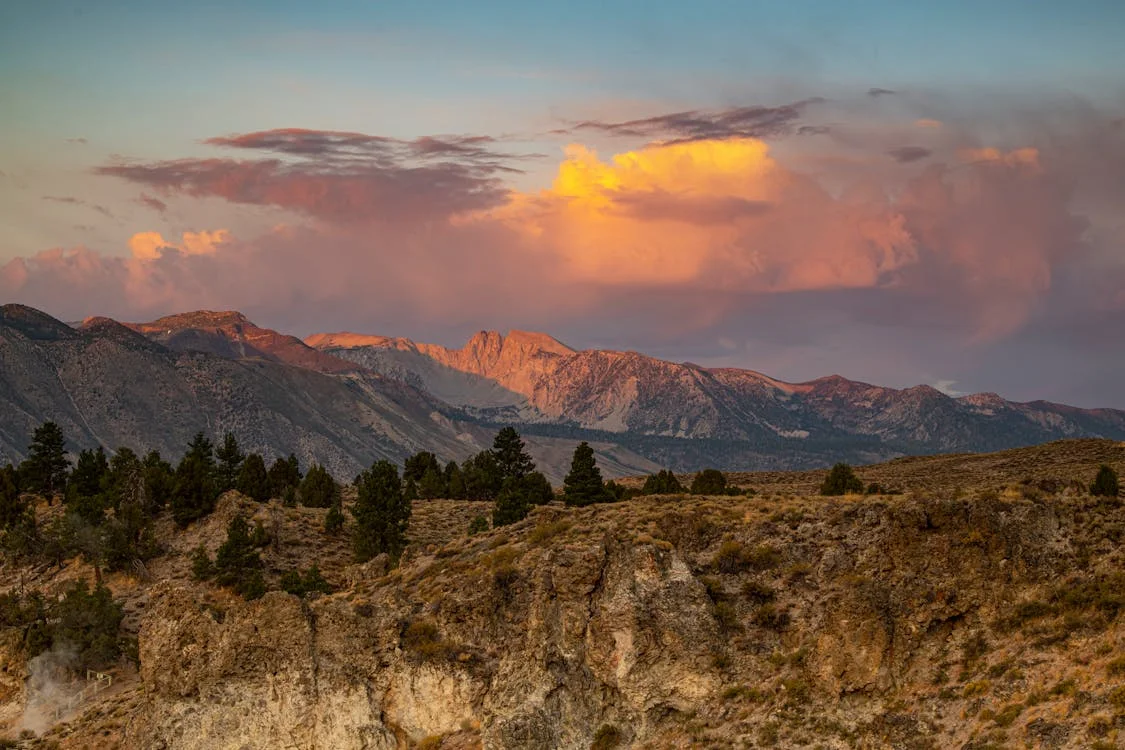
Image: Grand Teton National Park
Glacier National Park – Rugged Peaks and Goat-Led Trails
With 700+ miles of trails and the nickname “Crown of the Continent,” Glacier is the definition of a hiker’s paradise. You’re walking where bighorn sheep and mountain goats out-climb you with ease.
- Must-Hike: Highline Trail – cliffside drama, epic views, and goat encounters
- Also Try: Grinnell Glacier Trail for a wild mix of lakes, ice, and bear-spotting chances
- Safety First: Bears are active here—carry bear spray and know how to use it
When to Go: July–September for full trail access and optimal wildlife sightings
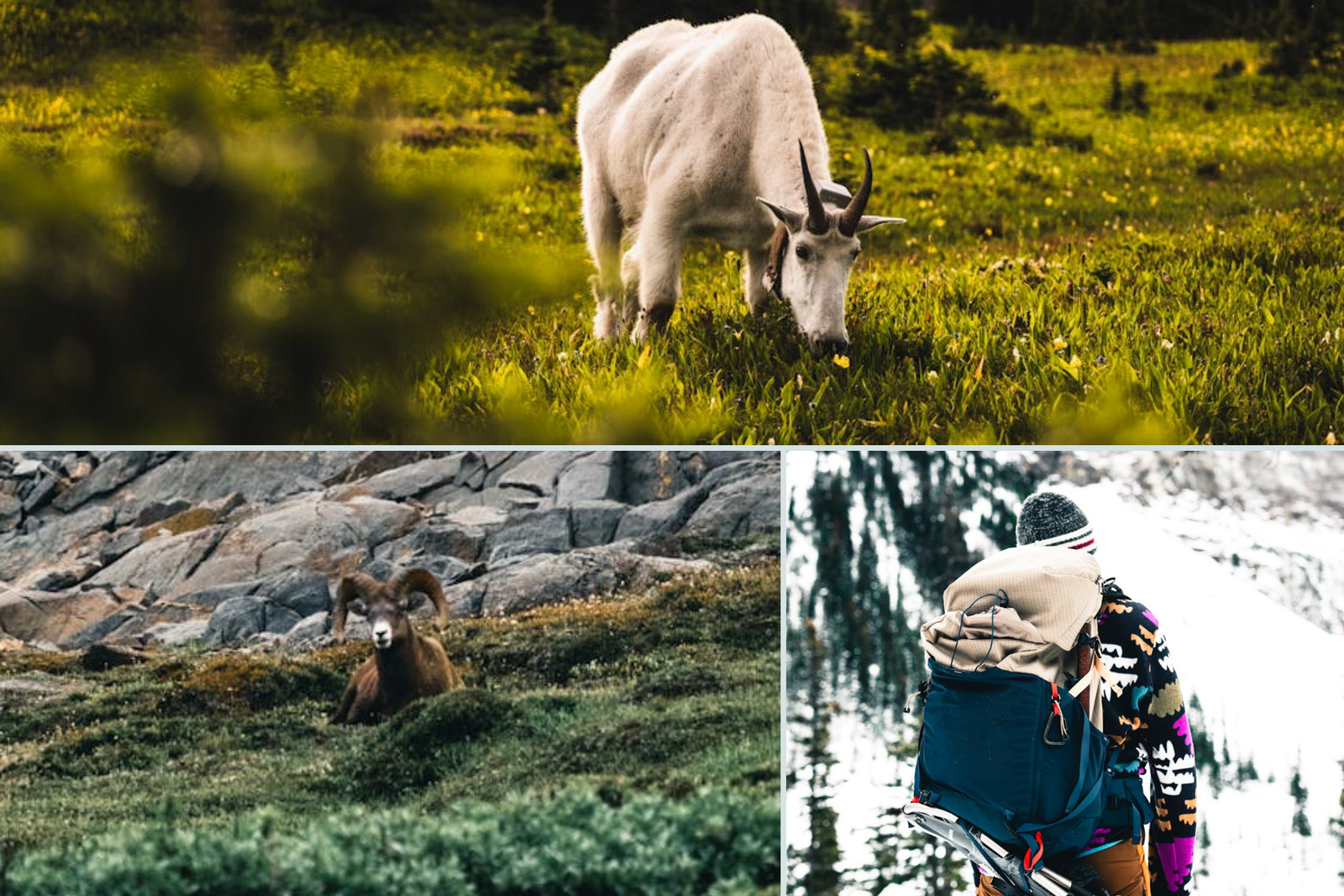
Image: Glacier National Park
Mount Rainier National Park – Volcanic Vistas and Marmot Mischief
Mount Rainier is massive—and magnificent. Its trails deliver dramatic elevation changes, flower-filled meadows, and close encounters with subalpine wildlife like marmots, deer, and even the occasional fox.
- Must-Hike: Skyline Trail from Paradise – classic Rainier views + wildlife-friendly terrain
- Go Higher: Burroughs Mountain Trail – for serious views of Rainier’s glaciers
- Know This: Weather turns fast here. Bring layers, check forecasts, and respect signs
When to Go: July–September (wildflowers peak late July!)
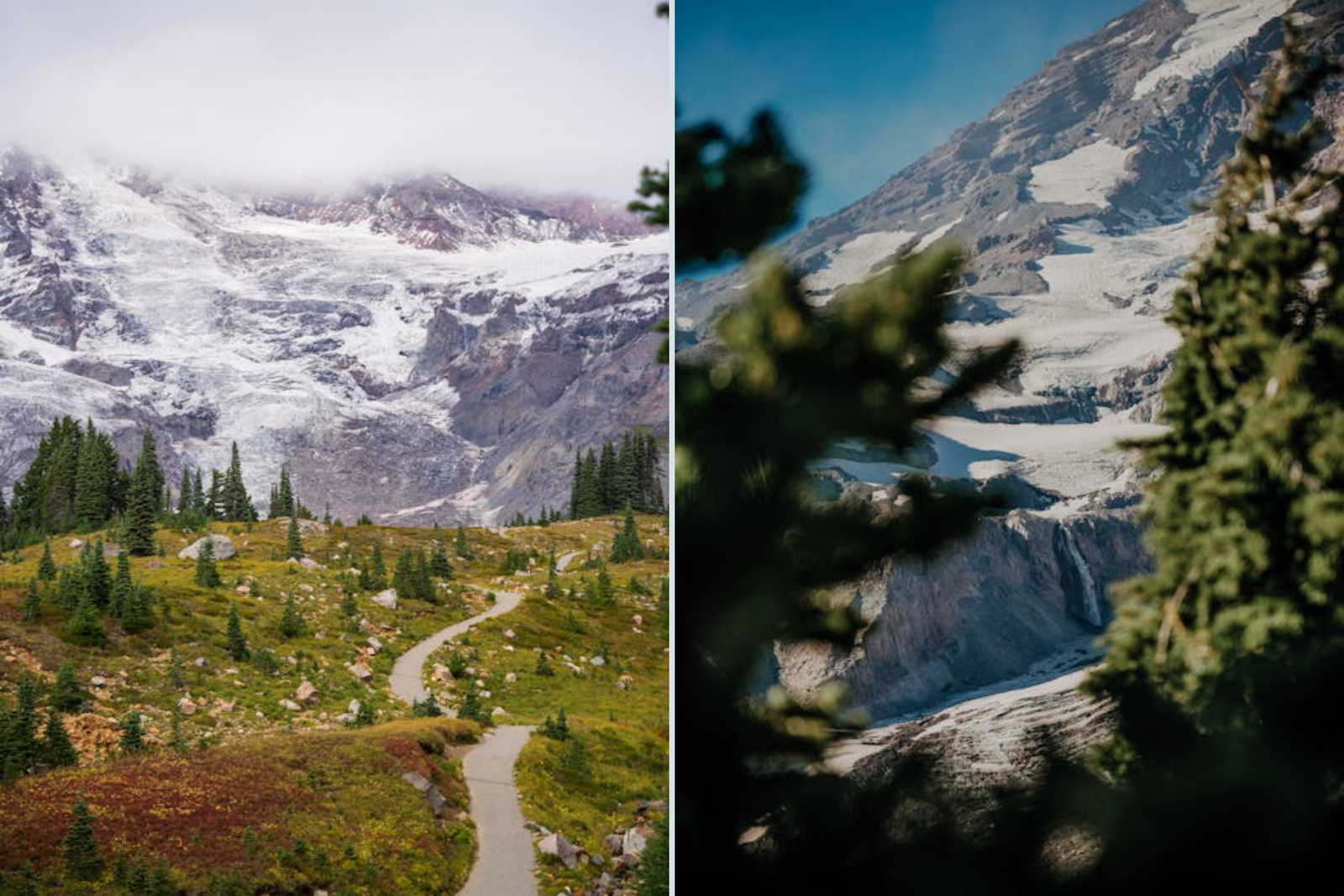
Image: Mount Rainier National Park
Forest Treks & Woodland Wildlife
For the soul who finds serenity in shade, and joy in quiet rustles between the trees, these parks offer some of the best national parks to visit for hiking and wildlife—especially if you’re chasing cooler air, ancient forests, and the subtle movement of forest-dwelling animals.
Olympic National Park – Rainforests, Rivers & Coastal Creatures
This park is like three ecosystems in one—temperate rainforest, alpine peaks, and rugged coastlines. That means your hike could include moss-draped trees and whale spouts in the distance.
- Short Hike: Sol Duc Falls Trail – lush, green, and full of birdlife
- Wildlife Watch: Sea otters, bald eagles, seals, and forest mammals in Elwha River Valley
- Forest Immersion: Elwha River Trail – old-growth vibes, quiet paths, and high wildlife potential
When to Go: May–October for dry trails and wildlife activity
Great Smoky Mountains National Park – Misty Trails & Bear Encounters
Don’t let the crowds scare you off—this park is famous for a reason. It’s home to one of the largest protected black bear populations in the Eastern U.S., and its hardwood forests explode with life year-round.
- Must-Try: Any of the Appalachian Trail segments, or shorter loops like Alum Cave
- Wildlife Tip: Early morning hikes = best chance to spot black bears, deer, wild turkeys
- Important: Store food properly—bears are smart and curious
When to Go: Spring for wildflowers, fall for color, summer for active wildlife
If you’re planning to explore Yellowstone or Yosemite, don’t miss our guide to the best road trip routes in the USA.
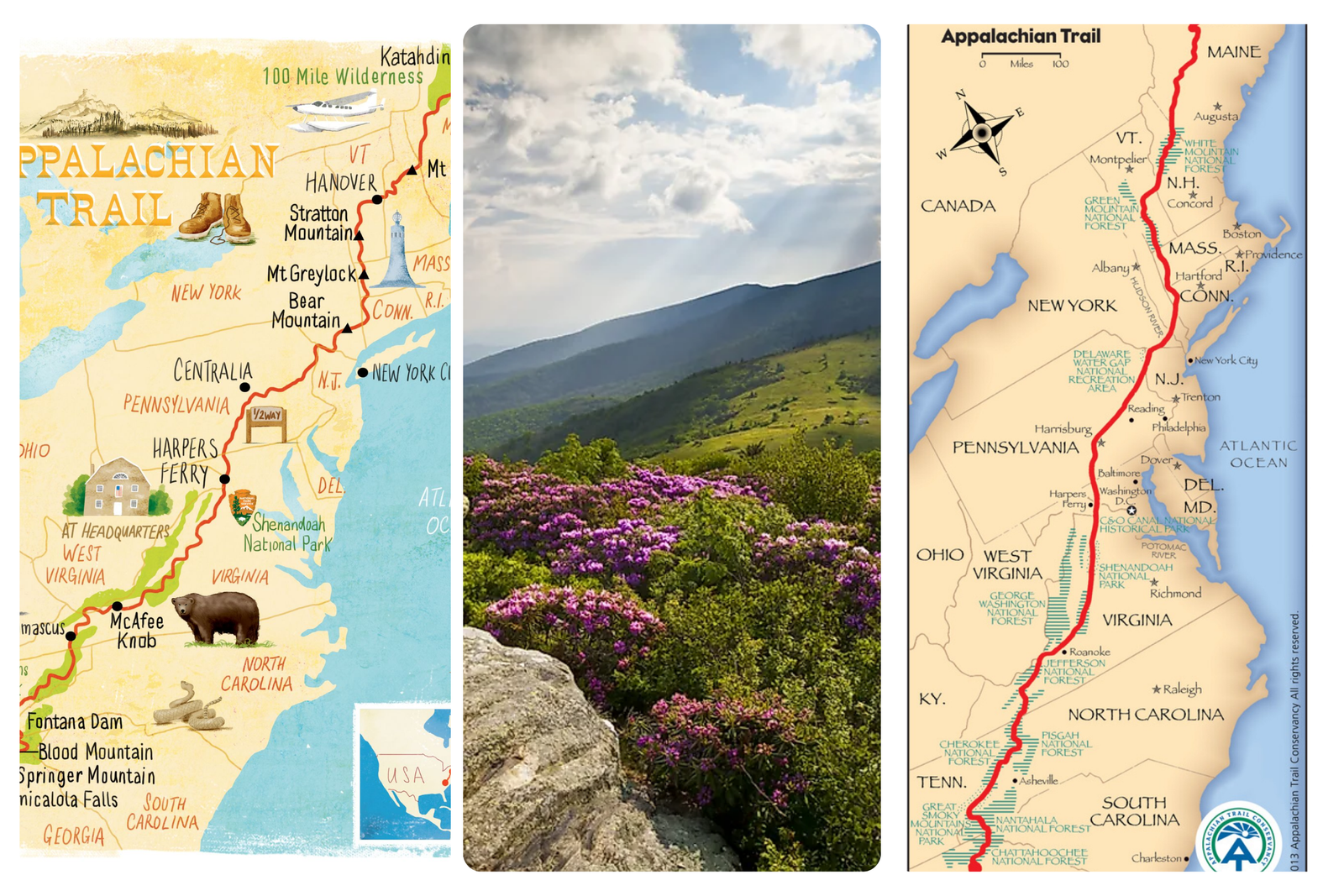
Image: Appalachian Trail
Desert Trails & Resilient Creatures
Drawn to the drama of red rocks, slot canyons, and sun-baked solitude? These desert parks are wild, ancient, and full of life that’s evolved to thrive under pressure.
Grand Canyon National Park – Canyon Majesty & Mule Deer Moments
There’s no trail quite like one that descends into the world’s most iconic canyon. Even if you’re not going rim-to-river, every step down the South Kaibab Trail is an unforgettable journey.
- Top Trail: South Kaibab Trail – start early, bring water, and soak in the silence
- Wildlife Watch: Mule deer, lizards, California condors circling high above
- Desert Reminder: Heat and exposure are real—prepare accordingly
When to Go: March–May, or September–November for cooler temps

Image: Grand Canyon National Park
Badlands National Park – Prairie Wildlife & Alien Landscapes
This park looks like another planet—but its eroded cliffs and open grasslands are very much alive. The Notch Trail is short but adventurous (hello, ladder climbs), and you’ll likely share your hike with bison and bighorn sheep.
- Trail Pick: Notch Trail – dramatic views with a bit of thrill
- Wildlife Bonus: Prairie dogs, antelope, and soaring hawks
- Vibe: Wide-open skies and stark beauty—it’s haunting in the best way
When to Go: Late spring and fall for mild weather + wildlife movement
Arches & Canyonlands National Parks – Red Rock, Ancient Routes & Tough Creatures
Utah’s desert wonders are unreal. Arches is compact but packed with photogenic formations, while Canyonlands is vast, rugged, and perfect for solitude seekers.
- Arches: Devil’s Garden Trail – see multiple arches in one hike
- Canyonlands: Explore Needles District for wildlife, fewer crowds, and even ancient petroglyphs
- Wildlife Tip: Lizards, desert cottontails, birds of prey, and possibly ringtails at night
When to Go: Spring and fall = ideal temps, fewer tourists
🌍 Love the outdoors? Here’s how to camp in the world’s most epic spots — including some of these national parks!
Coastal Hikes and Marine Life
Love the sound of crashing waves, salt air in your lungs, and the thrill of spotting a seal or puffin off the coast? Then these ocean-loving parks deserve a place on your bucket list of the best national parks to visit for hiking and wildlife.
Acadia National Park – Rugged Coastlines & Feathered Friends
Perched on Maine’s jagged shoreline, Acadia is where coastal beauty meets avian diversity. Whether you’re chasing sunrise from Cadillac Mountain or gripping iron rungs on the Beehive Trail, there’s plenty to spot along the way.
- Must-Hike: Cadillac Summit Loop for panoramic Atlantic views at dawn
- Birdwatcher’s Paradise: Warblers, puffins (in season), seabirds galore
- Coastal Classic: Ocean Path Trail – flat, scenic, and full of tide pool life
When to Go: May–October for clear skies, active wildlife, and accessible trails
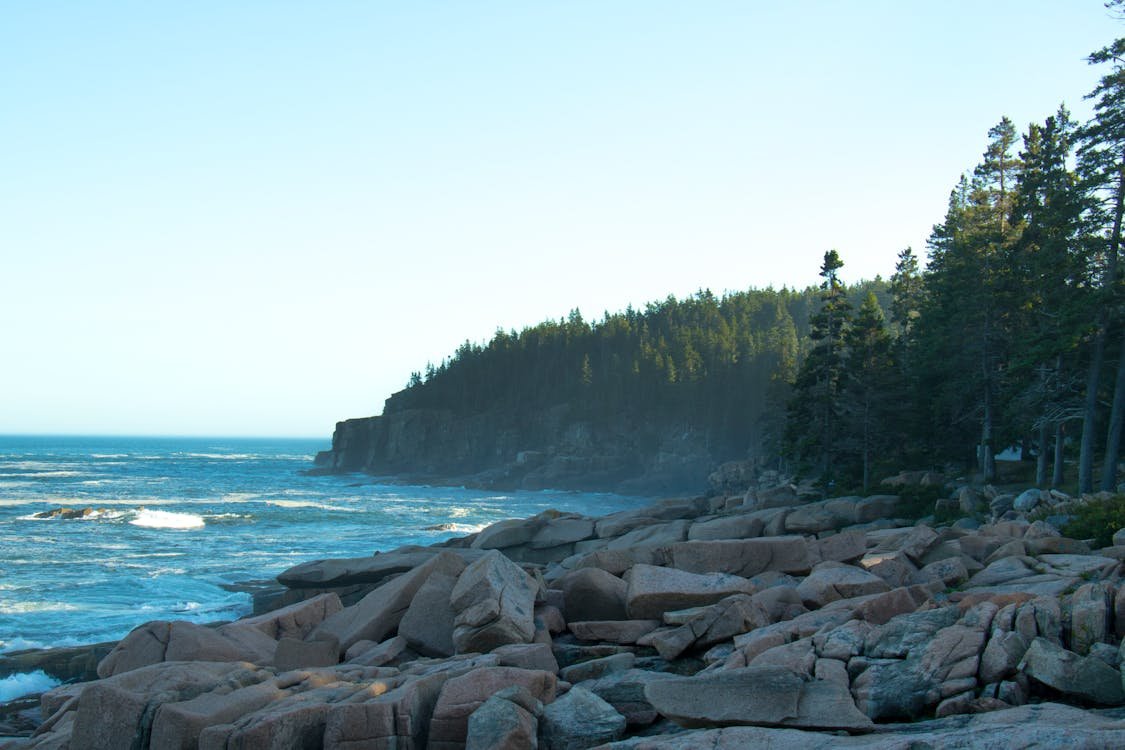
Image: Acadia Coastal Trail
Unique Landscapes and Specialized Wildlife
For the trailblazers and curious souls who crave the strange, the surreal, and the sublime—these are some of the best national parks to visit for hiking and wildlife where the land feels like another planet, and the wildlife plays by different rules.
Everglades National Park – Boardwalks & Reptilian Royalty
Welcome to the “River of Grass.” Hiking here isn’t always about dirt trails—it’s about wooden boardwalks over wetlands teeming with life. If you’ve never shared a path with an alligator before… this is your moment.
- Easiest & Wildest: Anhinga Trail – short, flat, and bursting with wildlife
- Creature Count: Alligators, turtles, spoonbills, herons, and even panthers (if you’re lucky!)
- Explorer Mindset: Embrace the swampy, slow-dripping silence—it’s mesmerizing
When to Go: Dry season (December–April) = more wildlife, fewer mosquitoes
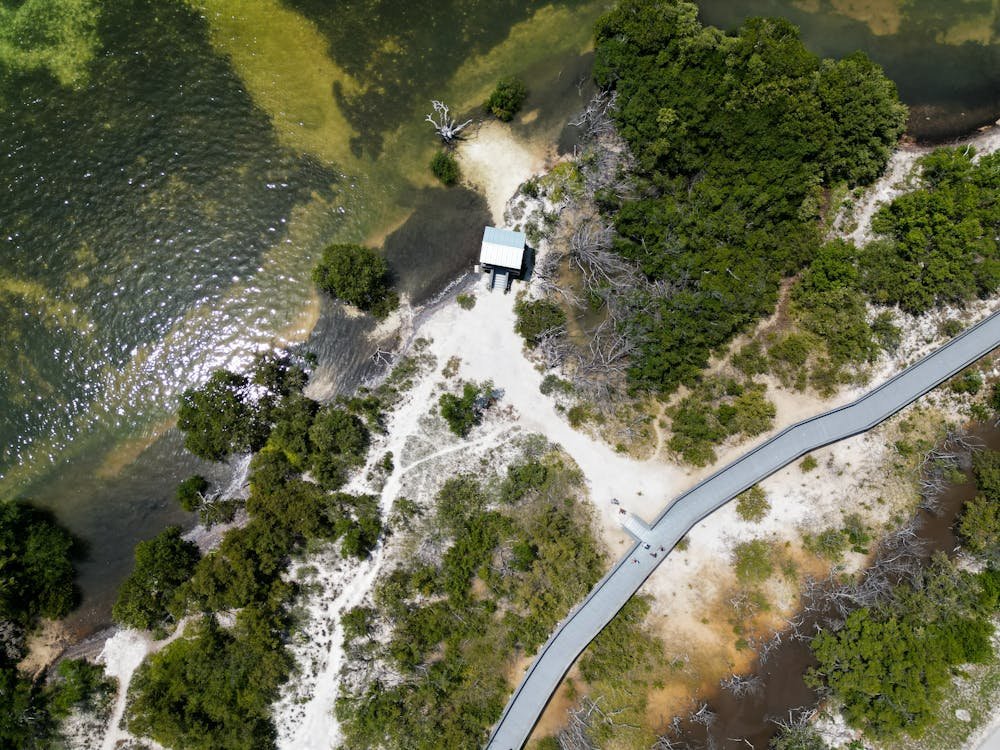
Image: Everglades
Yellowstone National Park – Geysers, Bison & Big Moments
Yellowstone is raw, untamed magic. You might be walking a boardwalk beside steaming vents one minute, and spotting bison herds in a wide valley the next. The hikes are often mellow, but the experiences? Next level.
- Where to Wander: Geyser Hill Loop – bubbling pools + surreal scenery
- Wildlife Galore: Elk, wolves, bison, bears—even otters near rivers
- Why It’s Special: You’re hiking in one of the most geologically active places on Earth
When to Go: Late spring or early fall for active wildlife and thinner crowds
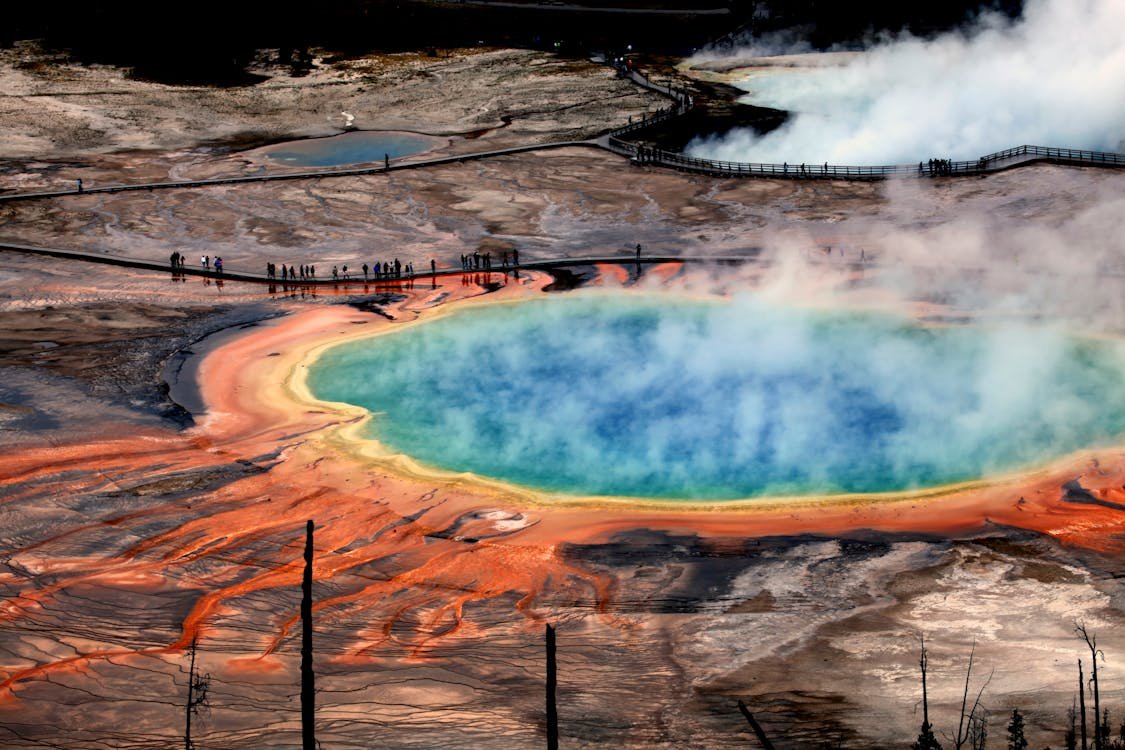
Image: Yellowstone National Park
III. Planning Your Hiking and Wildlife Adventure: Your Actionable Checklist
Exploring the best national parks to visit for hiking and wildlife is wildly rewarding—but a little prep goes a long way.
Here’s your no-fuss, trail-tested, field-approved checklist to help you hike smart, spot wildlife safely, and soak up every unforgettable moment.
- A. Choose the Right Park & Trail for You
- What’s your vibe? Alpine climbs? Rainforest loops? Desert solitude?
- Check trail info: Distance, elevation, difficulty, and recent reports (use park sites + AllTrails)
- Be honest about fitness level—ambition is great, but safety is better
- Check closures: Wildfires, snow, or maintenance can shut down trails without warning
- B. Wildlife Viewing Best Practices (Safety First!):
- Keep your distance – bring a zoom lens or binoculars, not your feet
- Dawn & dusk = prime time for animal activity
- In bear country? Always carry bear spray (and practice using it!)
- Store food smart: Use bear-proof containers or proper hangs
- Stay on trail: Protect nests, dens, and your own ankles
- C. Essential Hiking Gear for Varied Terrains (Pack Smart, Not Heavy):
- Footwear
- Sturdy boots = must-have for most parks
- Water shoes for wet hikes like Zion’s Narrows
- Clothing
- Layer up: moisture-wicking base, insulating mid, waterproof outer
- Hat, gloves, and warm layers—even in summer at altitude!
- Navigation
- Download offline maps (AllTrails, Gaia GPS)
- Carry a physical map + compass (because phones die)
- Safety Gear
- First-aid kit
- Headlamp or flashlight
- Sunscreen, insect repellent, whistle
- Hydration & Fuel
- Water (bladders or bottles)
- Electrolytes & high-energy snacks
- Tech
- Portable power bank
- Optional: GoPro, binoculars, camera lens
- Footwear
- D. Permits, Reservations & Logistics
- Popular hikes need permits! (e.g. Angels Landing) → Check recreation.gov
- Park fees add up → Get the America the Beautiful Pass if visiting multiple parks
- Know the shuttle system & parking rules
- Book campsites/lodging early, especially spring–fall
- Timed entry reservations required in some parks (e.g. Yosemite, Glacier)
- E. Leave No Trace Principles (Be a Responsible Explorer):
- Leave No Trace (Because Nature Deserves It)
- Pack it in, pack it out
- Stay on trail
- Leave what you find
- Minimize campfire impact
- Respect wildlife
- Be kind to other visitors
- Plan ahead & be prepared
For travelers heading down under, our roundup of Australia’s best road trips offers perfect pairings with iconic national parks.
IV. Enhancing Your National Park Experience
Once you’ve chosen from the best national parks to visit for hiking and wildlife, it’s time to level up your experience—from memorable moments to deeper connection with the places you explore.
Here’s how to go from “just a hike” to “trip of a lifetime.”
Join a Ranger Program
Want to know which trail has the most elk sightings right now? Or how that epic canyon was carved? Ranger-led hikes and talks give you insider knowledge on wildlife, geology, and Indigenous history you won’t find on a trail sign.
- Check the visitor center or NPS app for the current schedule
- It’s like getting a mini TED Talk… in hiking boots
Travel During Shoulder Season
Spring and fall are the sweet spot for many national parks:
- Fewer crowds = quieter trails and better wildlife encounters
- Cooler weather = more comfortable hiking
- Seasonal color = major photo ops (wildflowers or foliage!)
Pro Tip: Lodging and campsite availability is often better too.
Download the Park’s Digital Tools
Tech-savvy doesn’t mean glued to a screen—it means hiking smarter.
- NPS App: Maps, alerts, opening times, and events
- Individual park apps: Some parks (like Yellowstone or Yosemite) have enhanced digital guides
- Download maps offline before you go—cell service gets patchy fast
Tap into the Hiker Community
Platforms like AllTrails and Gaia GPS aren’t just for route planning—they’re real-time community hubs. Check recent trail reports, wildlife sightings, and closures from fellow hikers.
- Read comments for honest reviews (“saw 2 moose near mile 3!”)
- See recent pics of trail conditions before you pack
Capture Memories (Without Being That Hiker)
By all means—take the photo. Snap the sunrise. Record the trail magic.
But…
- Never disturb wildlife for a better shot
- Don’t step off trail for “the perfect angle”
- Sometimes, put the camera down and just take it in
🎒 Your best memories might be the ones you never posted.
Planning a nature-filled adventure in New Zealand? Check out our 4–5 day road trip itineraries that take you through some of the most scenic national parks.
V. Conclusion: Embrace the Wild — Mindfully, Meaningfully
The call of the wild isn’t just poetic—it’s primal. And the best national parks to visit for hiking and wildlife offer the rare gift of letting us respond to that call with wonder, respect, and open-hearted curiosity.
Whether you’re tracing the edge of a canyon at sunrise, catching your breath as a moose crosses your path, or standing speechless before a glacier-fed lake, these moments linger far beyond the trail.
But they’re not just found by chance—they’re created through intentional planning, respect for the land, and using the right tools to stay safe, informed, and connected.
Even off the grid, you can stay online. Get a prepaid eSIM that works in and around U.S. national parks — perfect for maps, bookings, and sharing your epic views.
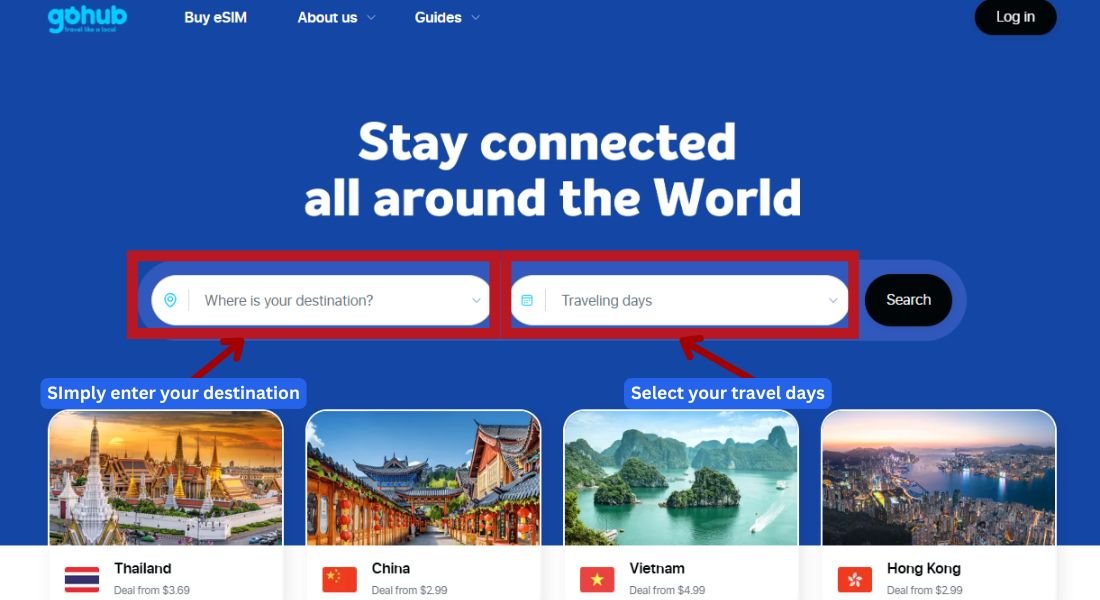
Image: Screenshot of the GoHub eSIM webpage, highlighting the destination input field with “Destination” selected, illustrating how users can easily search for eSIM data plans.
National parks often have limited connectivity, so make sure to get your travel eSIM before you go off the grid.


